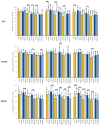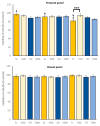Can Simulated Microgravity and Darkness Conditions Influence the Phytochemical Content and Bioactivity of the Sprouts?-A Preliminary Study on Selected Fabaceae Species
- PMID: 38891323
- PMCID: PMC11174765
- DOI: 10.3390/plants13111515
Can Simulated Microgravity and Darkness Conditions Influence the Phytochemical Content and Bioactivity of the Sprouts?-A Preliminary Study on Selected Fabaceae Species
Abstract
Sprouts' consumption has become popular due to their wide availability, easy cultivation process, and proven biological activity. Moreover, stress factors, such as limited access to light or disturbed gravity during growth, may contribute to the increased activity and the synthesis of bioactive compounds. In this study, for the first time, the examination of the impact of darkness and simulated microgravity conditions on the white clover sprouts from the Fabaceae family was conducted. Among several species, used in the preliminary attempts, only white clover was satisfactory sprouting in the disturbed gravity conditions, and thus was chosen for further examination. A random positioning machine setup was used during the cultivation process to simulate microgravity conditions. Additionally, the sprouts were cultivated in total darkness. Simulated microgravity and/or darkness during the first few days of the sprouts' growth caused biomass reduction, the increased synthesis of bioactive compounds (isoflavones and phenolics), and changes in the level of abscisic acid and phenylalanine ammonia-lyase. Moreover, it increased the antioxidant properties of the sprouts, while the enhancement of their cytotoxic impact was observed only for androgen-dependent prostate cancer LNCaP cells. To conclude, the presented results are promising in searching for novel functional food candidates and further studies are necessary, directed at other plant families.
Keywords: Fabaceae; antioxidant; cytotoxic; isoflavones; phenolics; simulated microgravity; sprouts.
Conflict of interest statement
The authors declare no conflicts of interest.
Figures






Similar articles
-
Bioactive compounds accumulation in Brassica sprouts grown under microgravity and darkness: A novel approach to functional foods.Food Chem. 2025 Nov 1;491:145324. doi: 10.1016/j.foodchem.2025.145324. Epub 2025 Jun 24. Food Chem. 2025. PMID: 40580596
-
Total polyphenols and bioactivity of seeds and sprouts in several legumes.Curr Pharm Des. 2013;19(34):6112-24. doi: 10.2174/1381612811319340005. Curr Pharm Des. 2013. PMID: 23448441 Review.
-
Chickpea and Lupin Sprouts, Stimulated by Different LED Lights, As Novel Examples of Isoflavones-Rich Functional Food, and Their Impact on Breast and Prostate Cells.Molecules. 2022 Dec 18;27(24):9030. doi: 10.3390/molecules27249030. Molecules. 2022. PMID: 36558162 Free PMC article.
-
Efficient preservation of sprouting vegetables under simulated microgravity conditions.PLoS One. 2020 Oct 15;15(10):e0240809. doi: 10.1371/journal.pone.0240809. eCollection 2020. PLoS One. 2020. PMID: 33057413 Free PMC article.
-
Strategies of Elicitation to Enhance Bioactive Compound Content in Edible Plant Sprouts: A Bibliometric Study.Plants (Basel). 2021 Dec 14;10(12):2759. doi: 10.3390/plants10122759. Plants (Basel). 2021. PMID: 34961237 Free PMC article. Review.
Cited by
-
Comparative Analysis of Polyphenolic Profile and Chemopreventive Potential of Hemp Sprouts, Leaves, and Flowers of the Sofia Variety.Plants (Basel). 2024 Jul 23;13(15):2023. doi: 10.3390/plants13152023. Plants (Basel). 2024. PMID: 39124141 Free PMC article.
-
Under simulated microgravity and gravity, anthocyanin is regulated by DcaWRKY2 in Dendrobium catenatum leaves.Front Plant Sci. 2025 Jan 20;15:1505199. doi: 10.3389/fpls.2024.1505199. eCollection 2024. Front Plant Sci. 2025. PMID: 39902202 Free PMC article.
-
Plant-Based Potential in Diabetes Management: In Vitro Antioxidant, Wound-Healing, and Enzyme Inhibitory Activities of Southern Algarve Species.Molecules. 2025 Jun 1;30(11):2432. doi: 10.3390/molecules30112432. Molecules. 2025. PMID: 40509318 Free PMC article.
References
-
- Grudzińska M., Galanty A., Paśko P. Can Edible Sprouts Be the Element of Effective Chemopreventive Strategy?—A Systematic Review of in Vitro and in Vivo Study. Trends Food Sci. Technol. 2023;139:104130. doi: 10.1016/j.tifs.2023.104130. - DOI
Grants and funding
LinkOut - more resources
Full Text Sources

